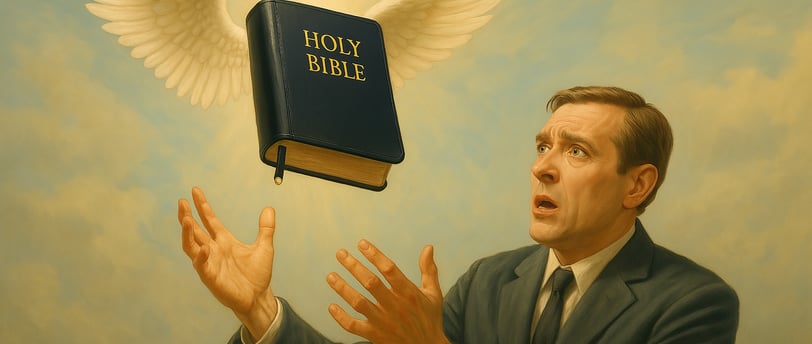Add your promotional text...
The Bible Didn’t Fall from Heaven with a Zipper: Who Decided It Was the Word of God?
The Bible didn’t fall from heaven, zipped and leather-bound. It was carefully discerned by the Church through centuries of councils, tradition, and guidance of the Holy Spirit. This post dives into how the 73 books of the Catholic Bible were chosen, who had the authority to decide, and why trusting that process matters today. Discover the history, the danger of private interpretation, and what Luther really thought of some New Testament books.t.
faithfacts
4/22/20252 min ler


📖 The Bible Didn’t Fall from Heaven with a Zipper: Who Decided It Was the Word of God?
1. The Bible Didn't Fall from Heaven with a Zipper
Have you ever stopped to ask yourself: Who decided the Bible is the Word of God?
Contrary to popular belief, the Bible didn’t just fall from the sky—leather-bound, zipped, and ready to go. The formation of the Bible was a long, historical process, guided by prayer, tradition, and discernment within the Church.
In this post, you’ll discover how the Bible was formed, who chose its books, and why it’s considered sacred and inspired by God.
2. The Bible Was Recognized — Not Delivered Finished
The Bible wasn’t instantly delivered to the early Christians. For centuries, Christian communities used various texts. It took time—and guidance from the Holy Spirit—for the Church to recognize which books were truly inspired. This recognition came through councils and synods, where bishops and theologians examined the writings carefully.
3. Key Historical Councils
- Council of Rome (382 AD): Pope Damasus I produced what’s known as the 'Damasine List', which included all 73 books of today’s Catholic Bible. It served as the basis for the Vulgate translation by St. Jerome.
- Synod of Hippo (393) & Council of Carthage (397 and 419): These councils explicitly confirmed the list of 73 inspired books, including the deuterocanonical books. They sent their decisions to Rome for ratification.
- Council of Florence (1441): Dogmatically reaffirmed the 73 books — 46 Old Testament + 27 New Testament.
- Council of Trent (1546): In response to the Protestant Reformation, the canon was solemnly declared dogma, reaffirming the Vulgate as the Church’s official biblical text.
4. How Many Books Are in the Catholic Bible?
- Old Testament: 46 books
- New Testament: 27 books
- Total: 73 books (including Tobit, Judith, Wisdom, Sirach, Baruch, 1 and 2 Maccabees)
5. St. Jerome and the Vulgate
Commissioned by Pope Damasus, St. Jerome translated the Bible into Latin between 383 and 405 A.D. Known as the Vulgate, his translation became the official and standard version of the Bible for the Western Church for many centuries. Jerome used Hebrew and Aramaic manuscripts for much of the Old Testament and relied on the Greek Septuagint for other books.
This translation also included all 73 books recognized by the Church—46 in the Old Testament and 27 in the New.
6. Why the Church’s Role Matters
The Bible is sacred because the Church, guided by the Holy Spirit, recognized its inspiration. The Church lived the Gospel before it was written and preserved the writings that matched the Apostolic Faith.
7. Why Does This Matter Today?
- Strengthens faith with historical truth
- Avoids personal or distorted interpretations
- Shows the harmony between Scripture, Tradition, and the Magisterium
- Reinforces trust in the Church’s authority
8. A Crucial Warning
Without a legitimate authority guided by the Holy Spirit, the biblical canon would be vulnerable to personal preferences and ideologies. A clear example of this danger is Martin Luther. Not only did he remove 7 books from the Old Testament for doctrinal reasons, but he also questioned New Testament books such as Hebrews, James, Jude, and Revelation. In his first German translation, these books were placed at the end of the Bible, almost like an appendix.
Source: Luther's 1522 German New Testament and his prefaces, especially the one on the Epistle of James, which he called 'an epistle of straw'.
Learn More
Follow @portalfaithfacts or visit www.faithfacts.portaljmj.com for more myth-busting and truth-grounded insights on Christian faith and history.
👉 Liked this content?
🔍 Follow @portalfaithfacts for more facts and myth-busting insights on Christian faith and Church history! 🧠 Real faith is even stronger when it's grounded in truth.
